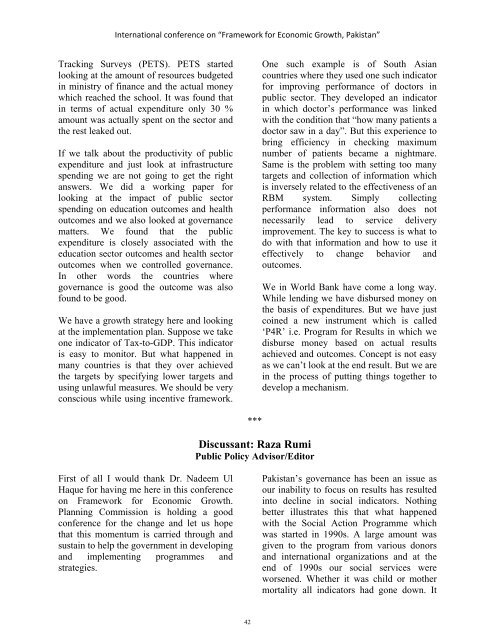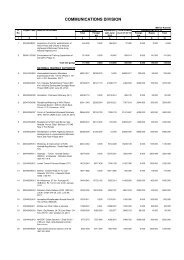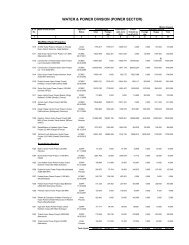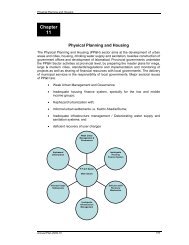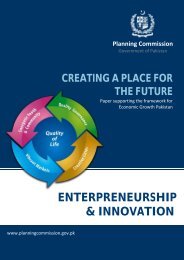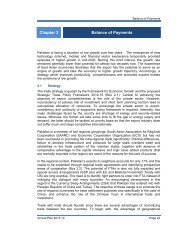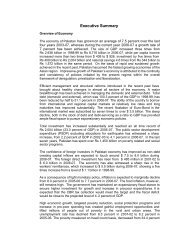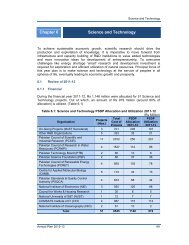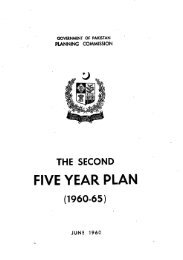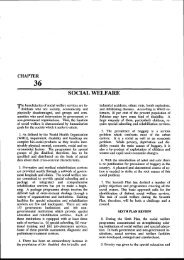Framework for Economic Growth, Pakistan - Planning Commission
Framework for Economic Growth, Pakistan - Planning Commission
Framework for Economic Growth, Pakistan - Planning Commission
Create successful ePaper yourself
Turn your PDF publications into a flip-book with our unique Google optimized e-Paper software.
International conference on “<strong>Framework</strong> <strong>for</strong> <strong>Economic</strong> <strong>Growth</strong>, <strong>Pakistan</strong>”Tracking Surveys (PETS). PETS startedlooking at the amount of resources budgetedin ministry of finance and the actual moneywhich reached the school. It was found thatin terms of actual expenditure only 30 %amount was actually spent on the sector andthe rest leaked out.If we talk about the productivity of publicexpenditure and just look at infrastructurespending we are not going to get the rightanswers. We did a working paper <strong>for</strong>looking at the impact of public sectorspending on education outcomes and healthoutcomes and we also looked at governancematters. We found that the publicexpenditure is closely associated with theeducation sector outcomes and health sectoroutcomes when we controlled governance.In other words the countries wheregovernance is good the outcome was alsofound to be good.We have a growth strategy here and lookingat the implementation plan. Suppose we takeone indicator of Tax-to-GDP. This indicatoris easy to monitor. But what happened inmany countries is that they over achievedthe targets by specifying lower targets andusing unlawful measures. We should be veryconscious while using incentive framework.One such example is of South Asiancountries where they used one such indicator<strong>for</strong> improving per<strong>for</strong>mance of doctors inpublic sector. They developed an indicatorin which doctor’s per<strong>for</strong>mance was linkedwith the condition that “how many patients adoctor saw in a day”. But this experience tobring efficiency in checking maximumnumber of patients became a nightmare.Same is the problem with setting too manytargets and collection of in<strong>for</strong>mation whichis inversely related to the effectiveness of anRBM system. Simply collectingper<strong>for</strong>mance in<strong>for</strong>mation also does notnecessarily lead to service deliveryimprovement. The key to success is what todo with that in<strong>for</strong>mation and how to use iteffectively to change behavior andoutcomes.We in World Bank have come a long way.While lending we have disbursed money onthe basis of expenditures. But we have justcoined a new instrument which is called‘P4R’ i.e. Program <strong>for</strong> Results in which wedisburse money based on actual resultsachieved and outcomes. Concept is not easyas we can’t look at the end result. But we arein the process of putting things together todevelop a mechanism.***Discussant: Raza RumiPublic Policy Advisor/EditorFirst of all I would thank Dr. Nadeem UlHaque <strong>for</strong> having me here in this conferenceon <strong>Framework</strong> <strong>for</strong> <strong>Economic</strong> <strong>Growth</strong>.<strong>Planning</strong> <strong>Commission</strong> is holding a goodconference <strong>for</strong> the change and let us hopethat this momentum is carried through andsustain to help the government in developingand implementing programmes andstrategies.<strong>Pakistan</strong>’s governance has been an issue asour inability to focus on results has resultedinto decline in social indicators. Nothingbetter illustrates this that what happenedwith the Social Action Programme whichwas started in 1990s. A large amount wasgiven to the program from various donorsand international organizations and at theend of 1990s our social services wereworsened. Whether it was child or mothermortality all indicators had gone down. It42


